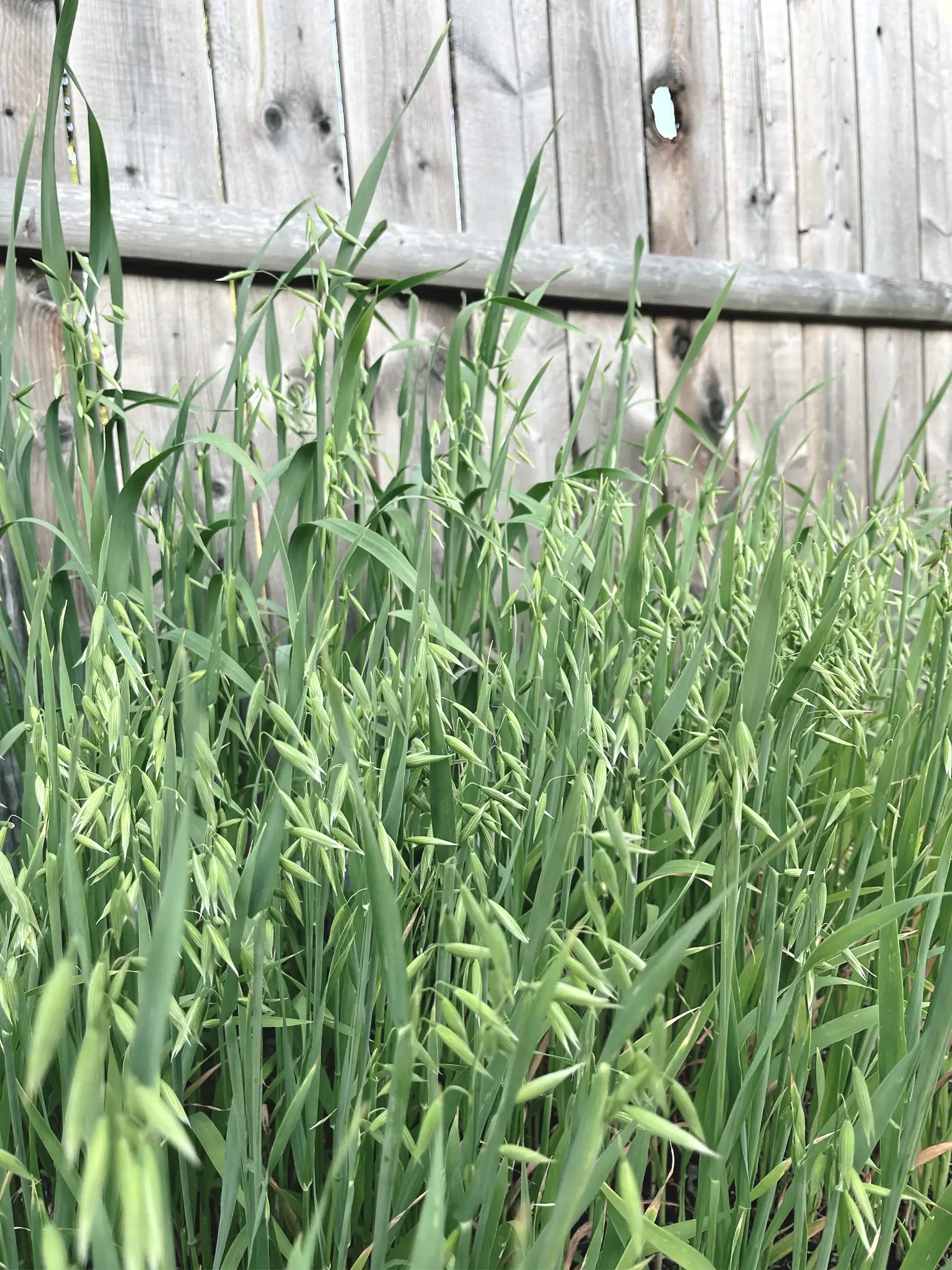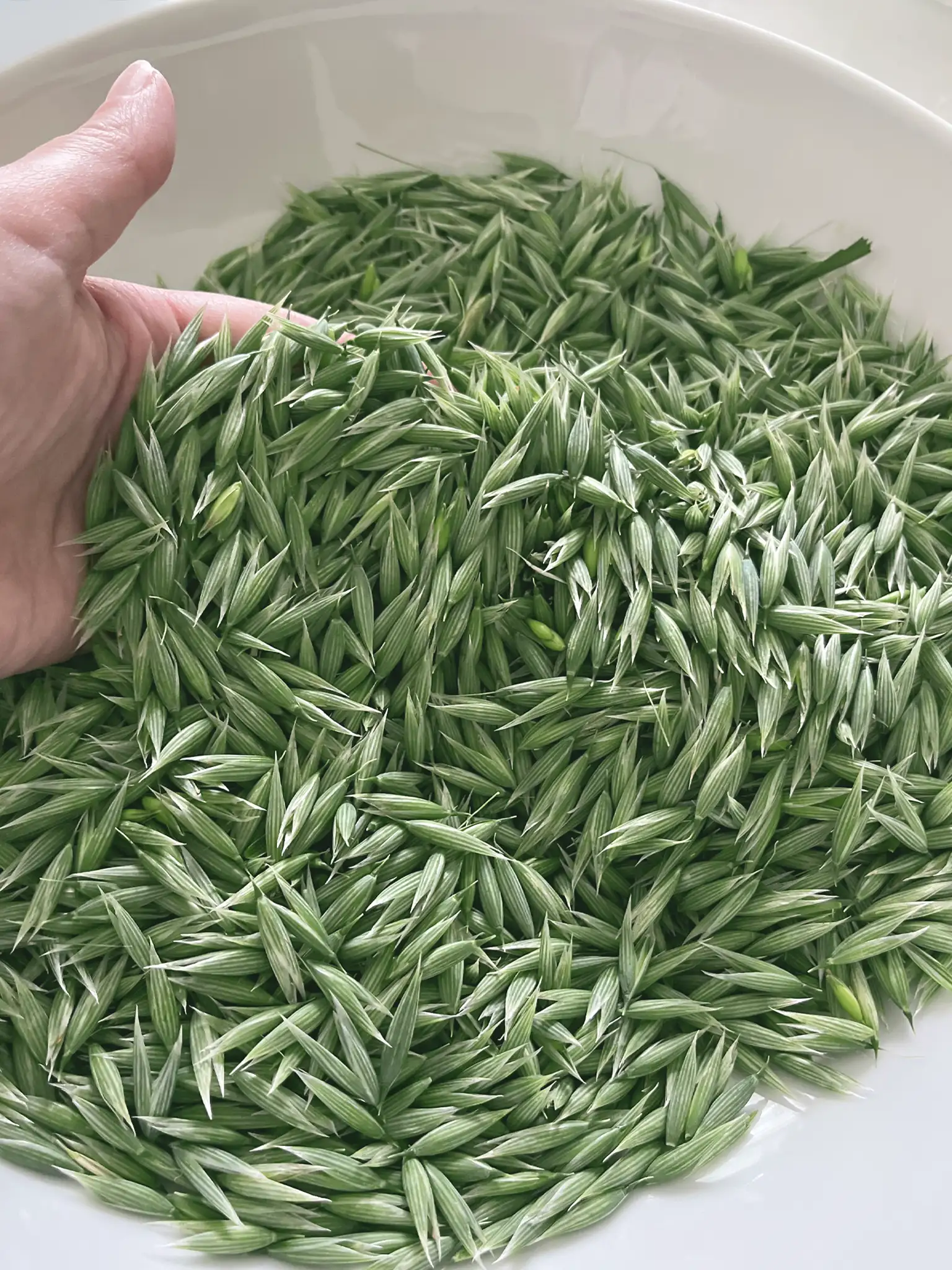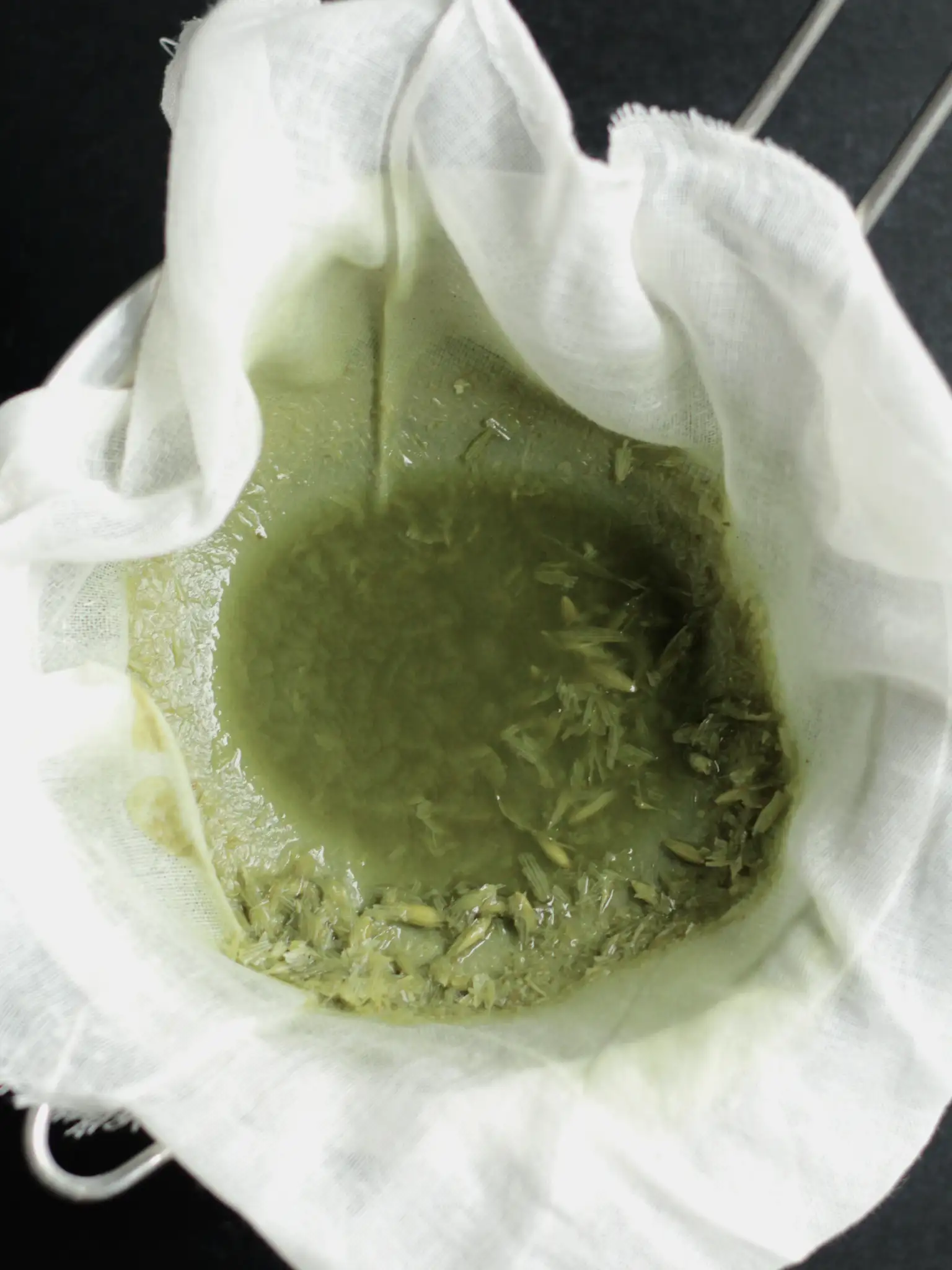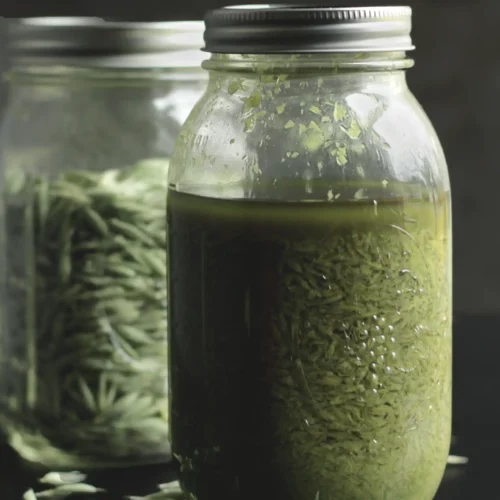Milky oats (also called oat tops) are the unripe seeds of the oat plant (Avena sativa). We harvest the oat tops during the “milky” stage when a white sap can be squeezed out of the immature seed. This stage occurs after the flowering stage and just before the seeds mature fully.
I sow oat seeds during the first week of April, and the milky oat tops are ready to harvest by late June.
Milky oats can help with stress, anxiety, exhaustion, and overall resilience. I use this tincture as a tonic to help nourish and soothe my frazzled nerves. I take it two times daily with a glass of water.
Read more about nervine herbs.

Overview
Tinctures are liquid extracts made from herbs that have been steeped in alcohol for an extended period of time. They’re a popular way to take herbal remedies because they’re easy to use and can be stored for several years. Tinctures can be taken on their own or added to drinks.
The recipe involves combining fresh milky oat tops into a high-proof alcohol for tincturing. The extraction takes about 4-6 weeks.
Equipment Needed

- Sterilized glass jar with a tight-fitting lid
- Cheesecloth or a fine-mesh strainer
- Funnel
- Amber glass dropper bottle
Ingredients
- 1 part fresh milky oat tops
- 2 parts high-proof alcohol (such as vodka or grain alcohol)
Instructions Summary
- Harvest: Harvest fresh milky oats at the “milky” stage. The window for this stage is short and only lasts a few days. Check your oat tops daily to know when to harvest.
- Prep: Sterilize your mason jar and make sure it’s completely dry before adding the ingredients. Blend the milky oats and alcohol in a very clean blender to help release the milky substance. Add the mixture to the sterilized jar. Make sure the oats are covered completely. Top off with a little more alcohol, as needed. The ratio of alcohol to milky oats should be roughly 2:1 (for example, 2 cups alcohol to 1 cup oats).
- Store: Place the jar in a cool, dark place and let it sit for about 4-6 weeks. Shake the jar once a day to mix everything around.
- Strain: After four to six weeks, strain the tincture using a cheesecloth and a fine-mesh strainer. Squeeze the oats in the cheesecloth to extract all of the liquid. Use a funnel to transfer the tincture into amber glass dropper bottles. The amber glass will protect the tincture from light and help to preserve its potency.
- Long-term storage: Label the tincture with the date and the name of the herb. Store it in a cool, dark place. A tincture can last for several years if stored properly.

How to sterilize your mason jar or glass jar
- Wash the jar with hot soapy water and rinse thoroughly.
- Boil water in a large pot.
- Once the water is boiling, carefully lower the jar into the pot.
- Let the jar sit in the boiling water for about 10 minutes to sterilize it.
- Use tongs to remove the jar from the boiling water and place it on a clean towel or drying rack.
- Let the jar air dry completely or dry it with a clean towel.
How to Use Milky Oat Tincture
It’s always best to consult with a qualified healthcare practitioner or herbalist who can help you determine the appropriate dosage based on your individual needs. However, here are some general guidelines for adults using a milky oat tincture:
Gentle Nervine Tonic: 1–2 droppers full (approximately 30–60 drops), taken 1–3 times daily as needed. You can start with a smaller amount, around 10–15 drops, once or twice a day to see how your body responds, especially if you’re new to using herbs.
Use consistently to help build resilience over time, as the gentle, nourishing effects compound with regular use.
Note: This information is general and for educational purposes only. Your personal health and dosing should be determined by you and your healthcare provider.
Contraindications of Milky Oats
Milky oats are generally considered safe for most people when consumed in reasonable amounts, but there are a few things to keep in mind:
- Celiac Disease: Oats are gluten-free but contain avenin, a protein that can cause reactions in some people with severe gluten sensitivities.
- Allergies: Although rare, some people may have an allergy to oats. Symptoms may include skin reactions, digestive upset, or respiratory issues like sneezing or a runny nose. Avoid milky oats if you know you have an oat allergy or are sensitive to oat-based products.
Join Our Newsletter
Sign up for our monthly newsletter to get easy gardening tips, seasonal to-dos, and herbal recipes delivered right to your inbox.
Thank you!
Check your email to confirm your subscription.

Milky Oat Tincture
Equipment
- Sterilized glass jar with a tight-fitting lid
- Cheesecloth or a fine-mesh strainer
- Funnel
- Amber glass dropper bottle
Ingredients
- 1 part fresh milky oat tops
- 2 parts high-proof alcohol such as vodka or grain alcohol
Instructions
- Harvest fresh milky oats at the “milky” stage. The window for this stage is short and only lasts a few days. Check your oat tops daily to know when to harvest.
- Sterilize your mason jar and make sure it’s completely dry before adding the ingredients. Blend the milky oats and alcohol in a very clean blender to help release the milky substance. Add the mixture to the sterilized jar. Make sure the oats are covered completely. Top off with a little more alcohol, as needed. The ratio of alcohol to milky oats should be roughly 2:1 (for example, 2 cups alcohol to 1 cup oats).
- Place the jar in a cool, dark place and let it sit for about 4-6 weeks. Shake the jar once a day to mix everything around.
- After four to six weeks, strain the tincture using a cheesecloth and a fine-mesh strainer. Squeeze the oats in the cheesecloth to extract all of the liquid. Use a funnel to transfer the tincture into amber glass dropper bottles. The amber glass will protect the tincture from light and help to preserve its potency.
- Label the tincture with the date and the name of the herb. Store it in a cool, dark place. A tincture can last for several years if stored properly.
Notes
-
- Celiac Disease: Oats are gluten-free but contain avenin, a protein that can cause reactions in some people with severe gluten sensitivities.
-
- Allergies: Although rare, some people may have an allergy to oats. Symptoms may include skin reactions, digestive upset, or respiratory issues like sneezing or a runny nose. Avoid milky oats if you know you have an oat allergy or are sensitive to oat-based products.
References
Kennedy, D. O., Bonnländer, B., Lang, S. C., Pischel, I., Forster, J., Khan, J., Jackson, P. A., & Wightman, E. L. (2020). Acute and Chronic Effects of Green Oat (Avena sativa) Extract on Cognitive Function and Mood during a Laboratory Stressor in Healthy Adults: A Randomised, Double-Blind, Placebo-Controlled Study in Healthy Humans. Nutrients, 12(6), 1598. https://doi.org/10.3390/nu12061598













